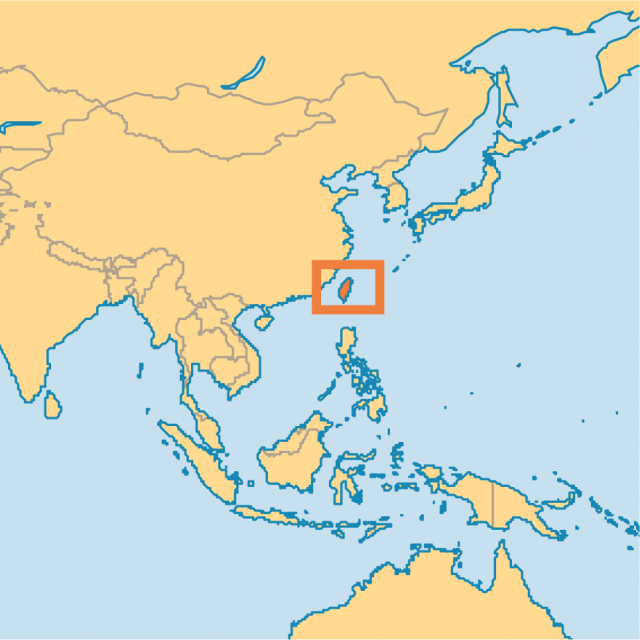Taiwan
Area 13,891 square mi (35,980 square km)
Population 22,603,001
Capital Taipei
Highest Point Yu Shan 12,962 ft (3,952 m)
Lowest Point 0 m
GDP per capita $18,000
Primary Natural Resources coal, natural gas, limestone, marble.
TAIWAN IS A mountainous island in the SOUTH CHINA SEA, with the Philippine Sea to the southeast, Luzon Strait to the south, the Taiwan Strait to the west, and the East China Sea to the north. Taiwan also controls the Pescadores Islands, the Quemoy Islands, and the Matsu Islands. Taiwan is a democratic entity that has a president as the chief executive and a unicameral legislature. Taiwan is divided into 16 counties and five municipalities. Its chief cities are Taipei, Kaohsiung, Taichung, and Tainan. Taiwan's international status remains uncertain because of its dispute with the People's Republic of CHINA, which claims it as a renegade province.

Taiwan's topography consists of mountains along the east and flat to gently rolling plains in the west. The climate is tropical with a rainy season from June to August and cloudy all through the year. The island of Taiwan is susceptible to earthquakes and typhoons. Its chief rivers are the Tanshui and the Choshui.
Human settlement in Taiwan can be traced to some 15,000 years ago during the Paleolithic age. The island's aborigines are traced to peoples who came from Southeast Asia and are related to the Malay peoples in MALAYSIA and INDONESIA. The first official Chinese contact with the island was in 239 C.E. when the emperor sent an expeditionary force to Taiwan. By the 13th century, Chinese immigrants settled on Taiwan from the province of Fukien on the mainland. (It was not until the Ming Dynasty [1368–1644] when the term Taiwan was used to name the island.)
The first Europeans to make contact with Taiwan were the Portuguese in 1517, who named the island Ilha Formosa meaning “beautiful island.” During the 17th century, Taiwan became a Dutch colony administered by the Dutch East India Company. The Chinese settlers on Taiwan, however, did not submit to Dutch rule and rebelled against the Dutch in 1640 and 1652. By 1661, the Dutch had left Taiwan. In 1644, remnants of Ming forces escaped to Taiwan after their overthrow by the Manchus from the north. By 1683, the Manchus subdued all of Taiwan. At the conclusion of the Sino-Japanese War in 1895, the Treaty of Shimonoseki awarded Taiwan to Japan. In many ways, Japanese rule brought stability and modernization to Taiwan through improvements in public health, education, economic infrastructure, and technology. However, the Japanese regarded Taiwan as a colony and imposed their language and culture upon the population.
In 1945, Taiwan became the Republic of China. In 1949, with the victory of the communists on the mainland, Nationalist anticommunist forces fled to Taiwan with the intention of mounting an attack to reclaim China. Mao Zedong had hoped to lead an invasion of Taiwan, but his plans were thwarted by U.S. support of Nationalist leader Chiang Kai-shek. For 20 years, the Republic of China, of which Taiwan was its sole remnant, was regarded as the legitimate government of China. During the 1960s, the tide was turning toward recognition of the People's Republic of China, most notably by the UNITED STATES which wanted to court BEIJING away from the Soviet Union.
On January 1, 1979, the United States normalized diplomatic relations with the People's Republic of China. The “One China Policy” was established, recognizing Taiwan as part of China, while continuing to provide for the defense of Taiwan. Between 1995 and 1996, in the midst of presidential elections in Taiwan, mainland China conducted war exercises in the Taiwan Strait. The United States responded by sending two aircraft carrier groups to Taiwan. In 2000, Taiwan experienced its first peaceful transfer of power from the Nationalist Party, which had ruled Taiwan for 50 years, to the Democratic Progressive Party under Chen Shuibian.
The population of Taiwan consists of 84 percent Taiwanese. Mainland Chinese make up 14 percent, while the aborigines make up the remaining 2 percent. The official language of Taiwan is Mandarin Chinese, though the Taiwanese and Hakka dialects are widely spoken.
Throughout the post-World War II period, Taiwan had one of the fastest-growing economies in the world. Taiwan has a free market capitalist economy that is one of the largest in Asia. Taiwan's largest trading partners are China and the United States. Taiwan's main exports are machinery, electronics, metals, textiles, plastics, and chemicals.